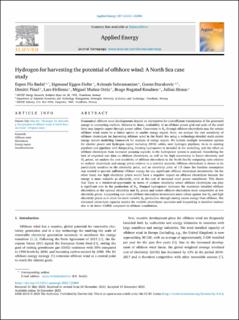| dc.contributor.author | Bødal, Espen Flo | |
| dc.contributor.author | Holm, Sigmund Eggen | |
| dc.contributor.author | Rammohan Subramanian, Avinash Shankar | |
| dc.contributor.author | Durakovic, Goran | |
| dc.contributor.author | Pinel, Dimitri | |
| dc.contributor.author | Hellemo, Lars | |
| dc.contributor.author | Muñoz Ortiz, Miguel | |
| dc.contributor.author | Knudsen, Brage Rugstad | |
| dc.contributor.author | Straus, Julian | |
| dc.date.accessioned | 2023-12-19T10:04:50Z | |
| dc.date.available | 2023-12-19T10:04:50Z | |
| dc.date.created | 2023-12-18T08:50:49Z | |
| dc.date.issued | 2024 | |
| dc.identifier.issn | 0306-2619 | |
| dc.identifier.uri | https://hdl.handle.net/11250/3108165 | |
| dc.description.abstract | Economical offshore wind developments depend on alternatives for cost-efficient transmission of the generated energy to connecting markets. Distance to shore, availability of an offshore power grid and scale of the wind farm may impede export through power cables. Conversion to H2 through offshore electrolysis may for certain offshore wind assets be a future option to enable energy export. Here, we analyse the cost sensitivity of offshore electrolysis for harvesting offshore wind in the North Sea using a technology-detailed multi-carrier energy system modelling framework for analysis of energy export. We include multiple investment options for electric power and hydrogen export including HVDC cables, new hydrogen pipelines, tie-in to existing pipelines and pipelines with linepacking. Existing hydropower is included in the modelling, and the effect on offshore electrolysis from increased pumping capacity in the hydropower system is analysed. Considering the lack of empirical cost data on offshore electrolysis, as well as the high uncertainty in future electricity and H2 prices, we analyse the cost sensitivity of offshore electrolysis in the North Sea by comparing costs relative to onshore electrolysis and energy prices relative to a nominal scenario. Offshore electrolysis is shown to be particularly sensitive to the electricity price, and an electricity price of 1.5 times the baseline assumption was needed to provide sufficient offshore energy for any significant offshore electrolysis investments. On the other hand, too high electricity prices would have a negative impact on offshore electrolysis because the energy is more valuable as electricity, even at the cost of increased wind power curtailment. This shows that there is a window-of-opportunity in terms of onshore electricity where offshore electrolysis can play a significant role in the production of H2. Pumped hydropower increases the maximum installed offshore electrolysis at the optimal electricity and H2 prices and makes offshore electrolysis more competitive at low electricity prices. Linepacking can make offshore electrolysis investments more robust against low H2 and high electricity prices as it allow for more variable H2 production through storing excess energy from offshore. The increased electrolysis capacity needed for variable electrolyser operation and linepacking is installed onshore due to its lower CAPEX compared to offshore installations. | en_US |
| dc.description.abstract | Hydrogen for harvesting the potential of offshore wind: A North Sea case study | en_US |
| dc.language.iso | eng | en_US |
| dc.publisher | Elsevier B. V. | en_US |
| dc.rights | Navngivelse 4.0 Internasjonal | * |
| dc.rights.uri | http://creativecommons.org/licenses/by/4.0/deed.no | * |
| dc.title | Hydrogen for harvesting the potential of offshore wind: A North Sea case study | en_US |
| dc.title.alternative | Hydrogen for harvesting the potential of offshore wind: A North Sea case study | en_US |
| dc.type | Peer reviewed | en_US |
| dc.type | Journal article | en_US |
| dc.description.version | publishedVersion | en_US |
| dc.source.volume | 357 | en_US |
| dc.source.journal | Applied Energy | en_US |
| dc.identifier.doi | 10.1016/j.apenergy.2023.122484 | |
| dc.identifier.cristin | 2214605 | |
| dc.relation.project | Norges forskningsråd: 308811 | en_US |
| dc.source.articlenumber | 122484 | en_US |
| cristin.ispublished | true | |
| cristin.fulltext | original | |
| cristin.qualitycode | 1 | |

